Labor and Porcelain in Japan
& Pottery and Porcelain
Industries of Japan
by Thomas B. Van Buren
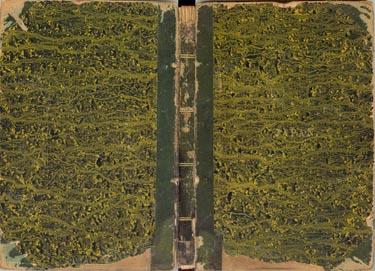
Click for a Larger Picture
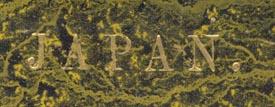
Only Lettering on Cover/Spine
Van Buren, Thomas B.:
Labor in Japan - together with - Pottery and Porcelain Industries of Japan, Yokohama, Japan, Printed at the Japan Gazette Office, 1882, 8vo (6 1/4 x 9 in - 15.7 x 23.3 cm), 59 pp + 10 pp. Contains eleven (11) hand colored albumen photographs (see below). Prepared by Thomas B. Van Buren, the U.S. Consul-General in Japan. This book contains two reports which were originally printed in the Reports of the Consuls of the United States, No. 2, November, 1880, published by the Department of State. The reports as published by the US Government have been slightly modified (corrected) and supplemented with eleven (11) hand colored albumen photographs interspersed in the text.
Images of the Meiji Emperor and Empress [Also shown below].
  I believe that the images of the Emperor and Empress in this book were taken by Kuichi Uchida and represent very early and scarce photographic images. Kuichi Uchida (1844-1875) was the first photographer allowed to photograph the Meiji Emperor and Empress. These were considered "Official" photographs. He took these photographs in the 1871~1873 period. While I have not been able to confirm the assertion, it has been stated that these images saw very restricted distribution because of a general prohibition against viewing the Emperor's face. It is established that in 1874, the mayor of Tokyo Prefecture issued an ordinance which prohibited the sale and personal possession of the imperial portrait. Apparently the Emperor was not photographed again until 1889. The later photographs became very popular and received widespread publication and distribution. Some believe that unauthorized copies of the "Official" photographs were distributed through the years, possibly by Baron Raimund von Stillfried und Ratenitz. Whether the early images of the Emperor and Empress by Uchida were restricted in publication as a mater of deliberate policy is an open question. The fact remains that original photographic reproductions of these first images (pre-1889), such as found in this book, are scarce.
I believe that the images of the Emperor and Empress in this book were taken by Kuichi Uchida and represent very early and scarce photographic images. Kuichi Uchida (1844-1875) was the first photographer allowed to photograph the Meiji Emperor and Empress. These were considered "Official" photographs. He took these photographs in the 1871~1873 period. While I have not been able to confirm the assertion, it has been stated that these images saw very restricted distribution because of a general prohibition against viewing the Emperor's face. It is established that in 1874, the mayor of Tokyo Prefecture issued an ordinance which prohibited the sale and personal possession of the imperial portrait. Apparently the Emperor was not photographed again until 1889. The later photographs became very popular and received widespread publication and distribution. Some believe that unauthorized copies of the "Official" photographs were distributed through the years, possibly by Baron Raimund von Stillfried und Ratenitz. Whether the early images of the Emperor and Empress by Uchida were restricted in publication as a mater of deliberate policy is an open question. The fact remains that original photographic reproductions of these first images (pre-1889), such as found in this book, are scarce.
Headings - Major Topics (Focus is generally the 1868~1880 period).
Part 1 - Labor in Japan.
- Latitude and longitude of Japan
- Topography
- Soil
- Water
- Climate
- Temperature
- Population
- Government
- Land Tenure
- Religion
- Education
- Medical science and education
- Morals
- Means of Transportation
- Mails
- Tenements
- Fuel
- Farmers
- Food
- Clothing
- Holidays
- Taxes
- Rice Culture
- Rice
- Wheat
- Barley
- Millet, Beans, Peas &c
- Tobacco
- Tea
- Silk
- Cotton
- Artisans
- Porcelain and Earthenware
- Enamels
- Ship builders
- Professional Labor
- Physicians
- Lawyers
- Writers, translators and interpreters
- Cooly or Common Labor
- Carriers
- Car-men
- Packers
- Fishermen
- Miners
- Sports and Pastimes
- Labor Organizations
- Finances
- Currency
- The Blind
- Scenery
- Ethnology
- Oriental Civilization
- Table A - Showing Prices of Food in Japan, According to Quality
- Table B - Japanese Taxation
Part 2 does not have headings.
[Items in Bold are presented as major topics in the text, other are sub-topics].
Illustrations. Each of the eleven (11) photographic illustrations is a hand colored albumen print. The general size is 3 1/2 x 5 1/2 in. The photographs are mounted on the same paper stock as the text. Each is enclosed with a box and has a descriptive title. The photographs are very detailed/sharp with crisp vivid hand coloring. This appears to be one of the first published illustrated books using these albumen prints. While tourist albums were being sold at this time with similar types of prints, they were not generally published/distributed as this book.
Labor in Japan
- His Imperial Majesty, Matsu Hito, Emperor of Japan.
(frontispiece)
- Her Imperial Majesty, Haruko, Empress of Japan.
(frontispiece)
- Ainos. (after page 6)
- A Samurai in Armor. (after page 14)
- Betto. (after page 20)
- Geisha, Playing on the Tsudzumi. (after page 28)
- Vegetable Pedlar. (after page 34)
- Museme, in Winter Costume. (after page 40)
- Coolie, in Winter Dress. (after page 48)
Pottery and Porcelain Industries of Japan
- Satsuma Vase, (In Possession of the Writer.) (after page 4)
- Kaga or Kutani Plate, (In Possession of the Writer.)
(after page 8)
Click on the Picture for Higher Resolution Picture.
His Imperial Majesty, Matsu Hito,
Emperor of Japan.
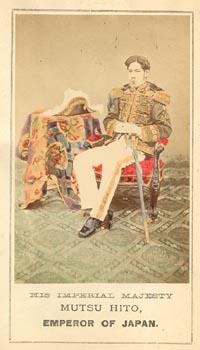
Her Imperial Majesty, Haruko,
Empress of Japan.

Ainos.
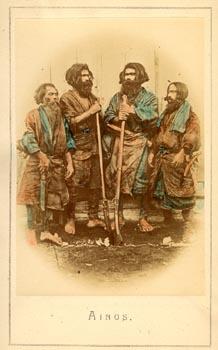
A Samurai in Armor.

Betto.
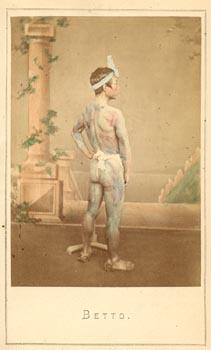
Geisha, Playing on the Tsudzumi.

Vegetable Pedlar.
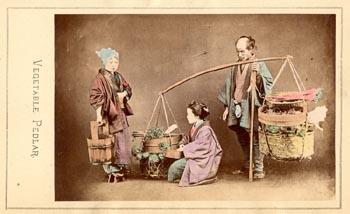
Museme, in Winter Costume.
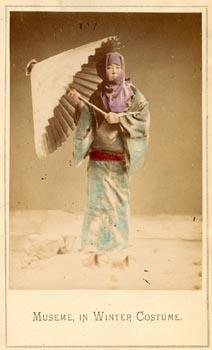
Coolie, in Winter Dress.
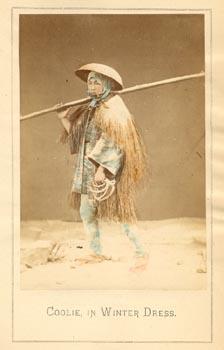
Satsuma Vase
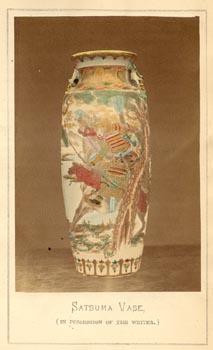
Kaga or Kutani Plate

Regarding the Mail, Van Buren Notes.
Mails.-- The mail transportation that has been established within the last ten years, both coastwise and inland, is cheap and excellent. The number of miles of mail routes aggregates 36,052. The number of Post Offices is 3,927. The number of letters carried for the year ending June 30th, 1880, was 55,775,206, and that of newspapers 11,203,731. These figures throw great light upon the volume of business of the country and the amount of reading writing done by the people. (Report on Labor in Japan, page 19).
Concordance.
Labor in Japan - together with - Pottery and Porcelain Industries of Japan, Yokohama, Japan Printed at the Japan Gazette Office, 1882, Title Page, Frontispiece hand colored albumen photographs (Emperor of Japan & Empress of Japan), Index to Report on Labor in Japan (2 pages), Index to Report on the Pottery and Porcelain Industries of Japan (2 pages), Part 1 - "Labor in Japan, Report by Consul-General Van Buren of the Topography, Soil, Climate, Laws, Religion, Government, Eductation, The Prices of Labor, Living, &etc., of Japan." (numbered pages 1-59 with seven (7) hand colored albumen photographs inserted but not numbered), Part 2 - "Pottery and Porcelain Industries of Japan, Report of Counsul-General Van Buren, of Kanagawa." (numbered pages 1-10 with two (2) hand colored albumen photographs inserted but not numbered).
|